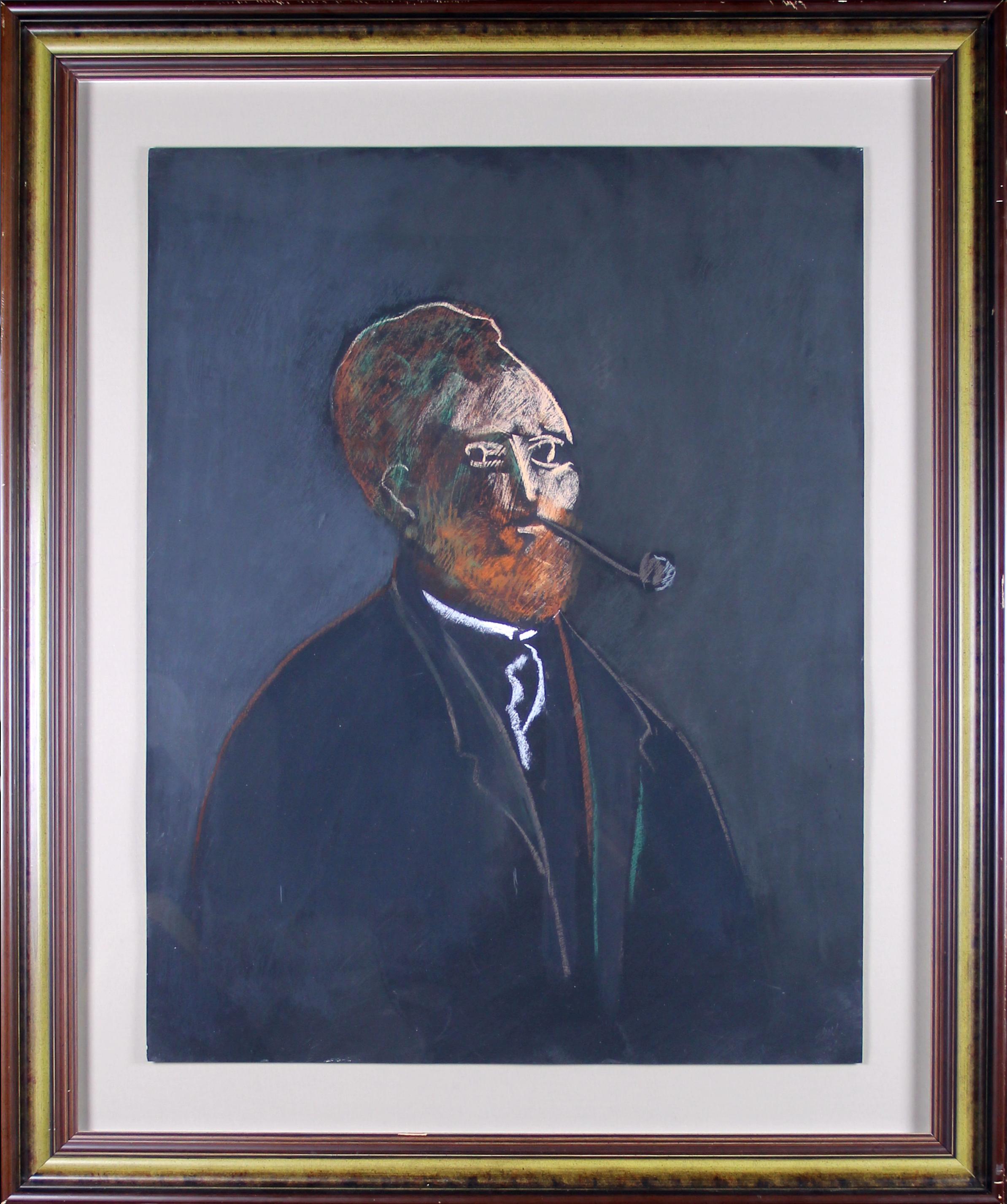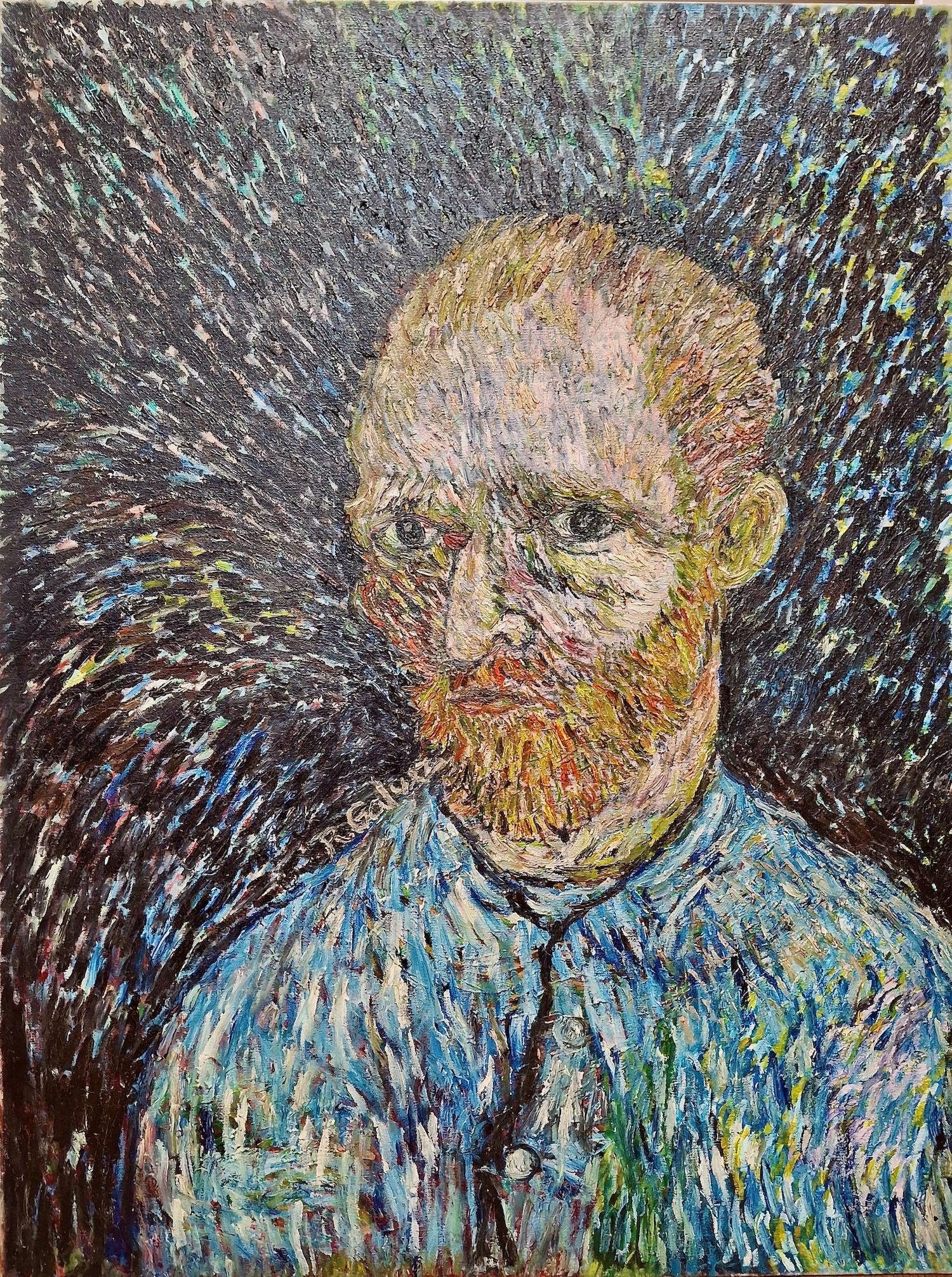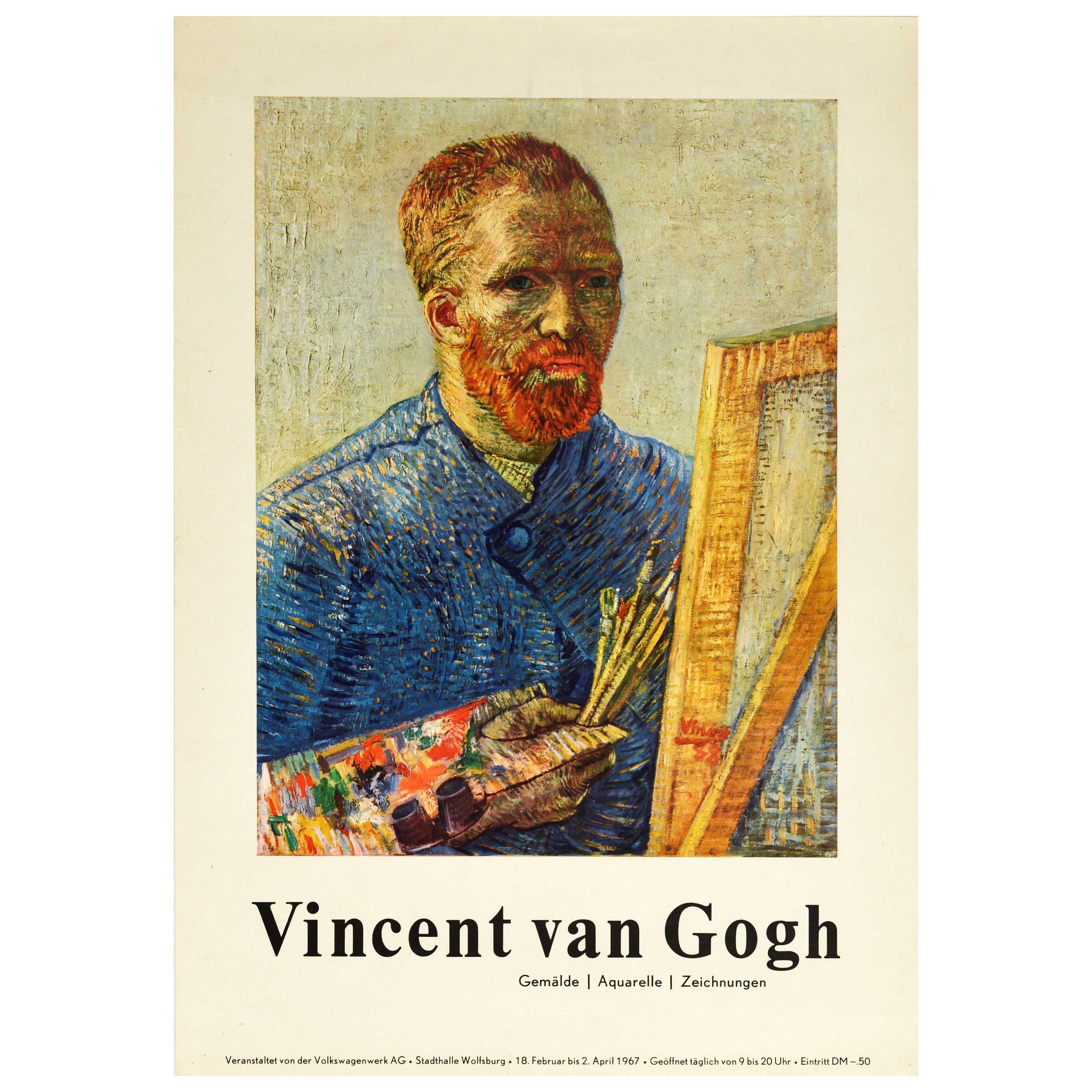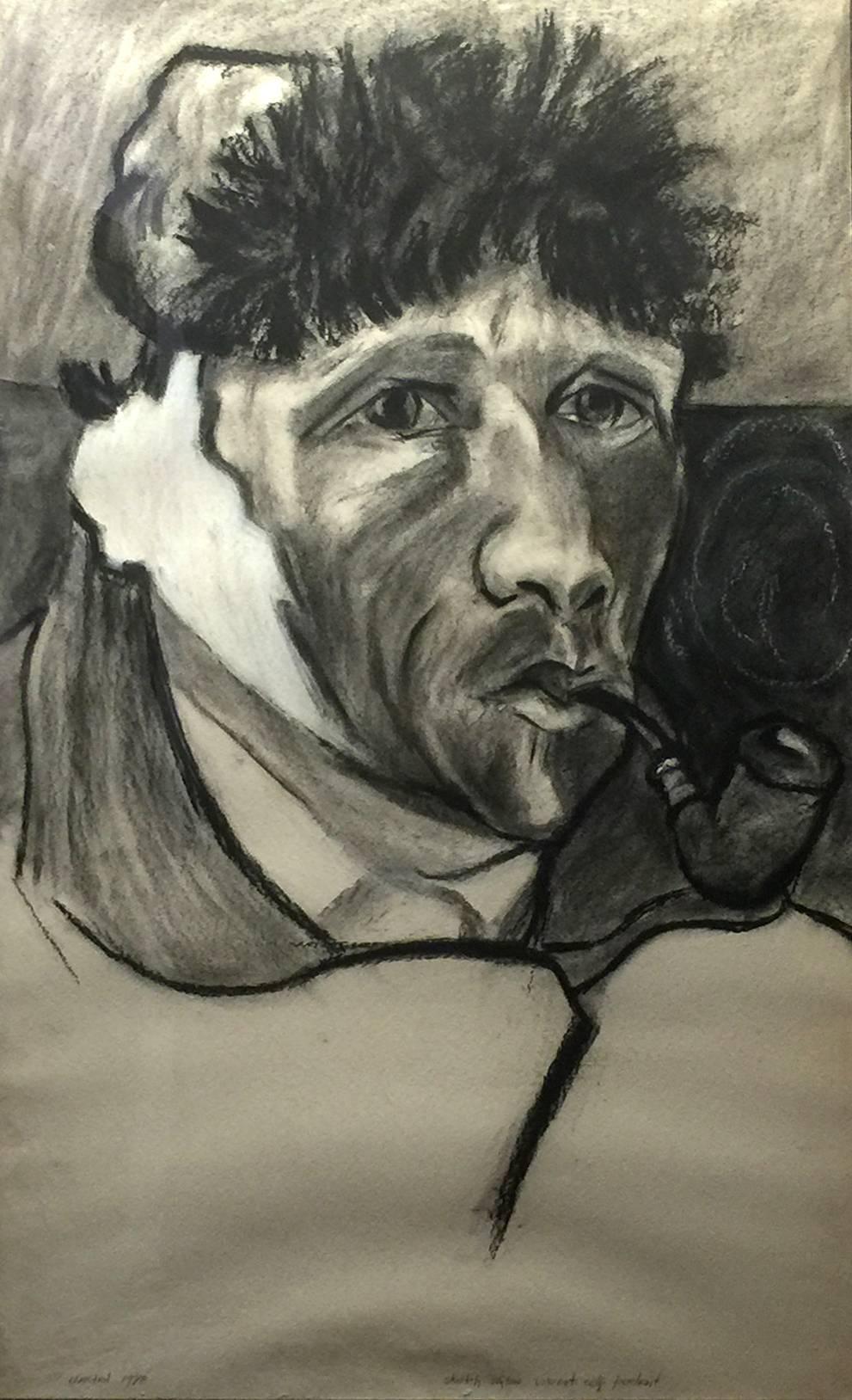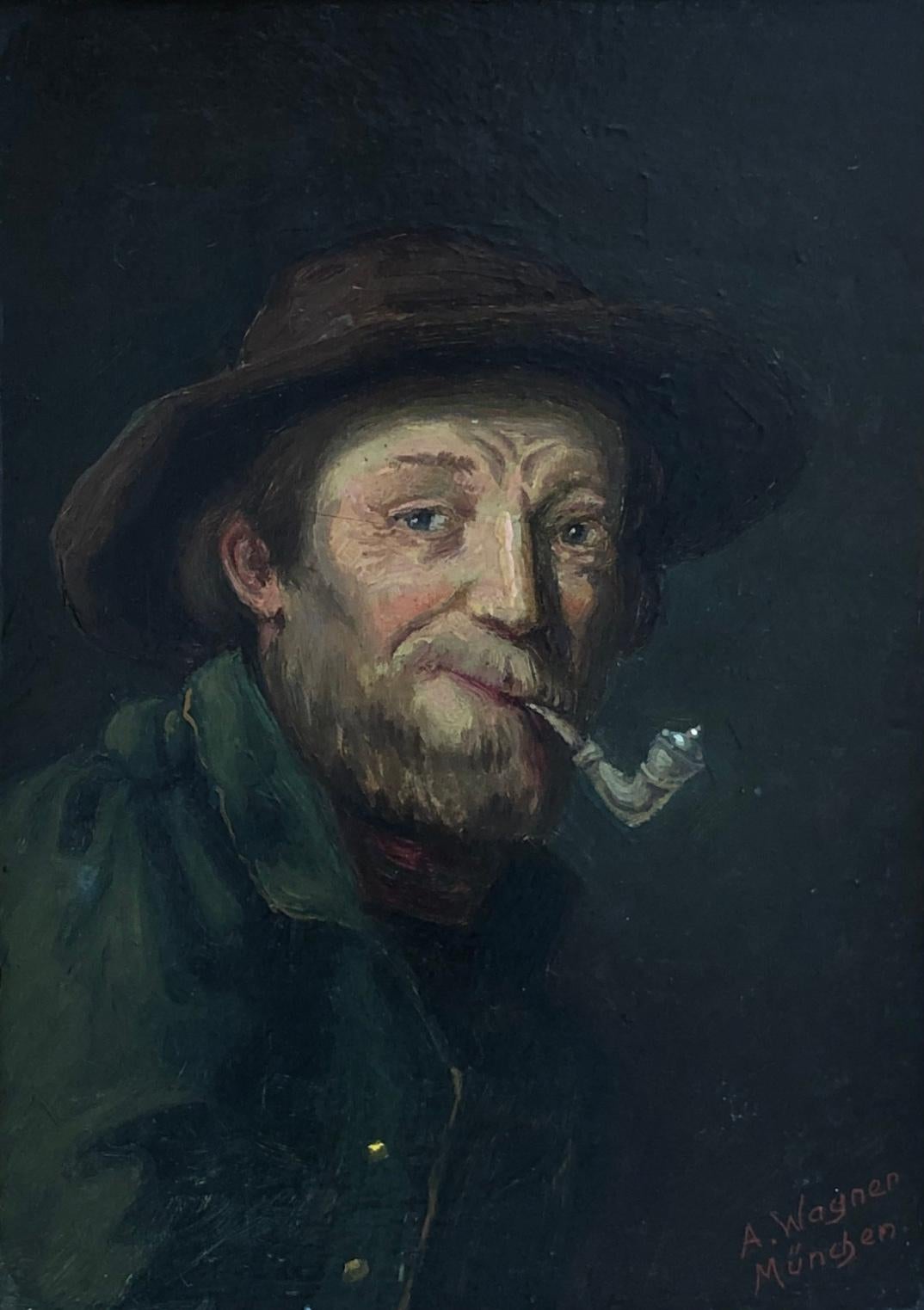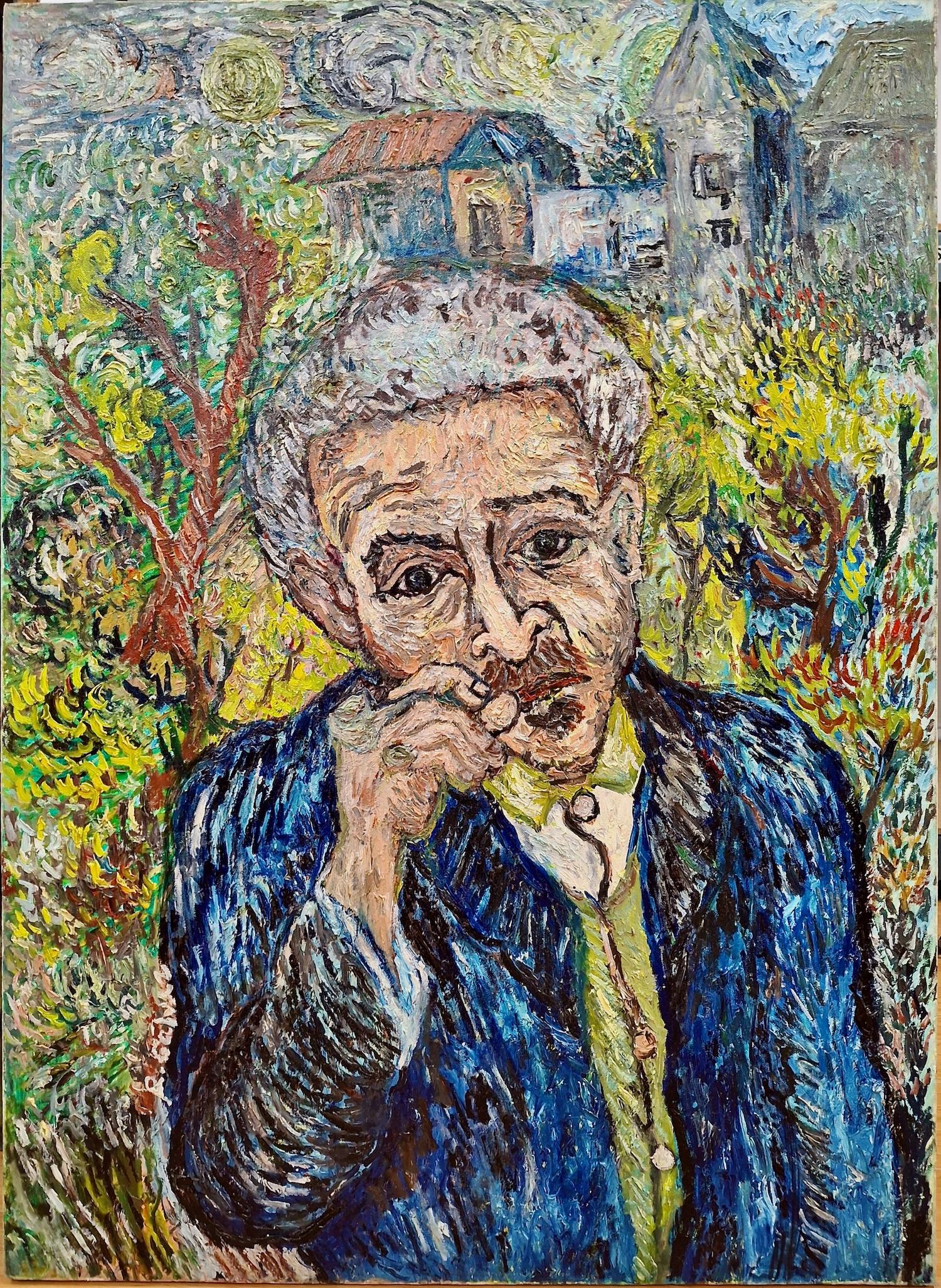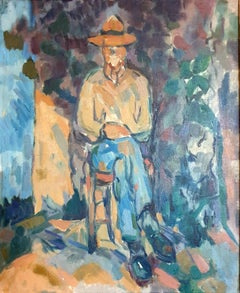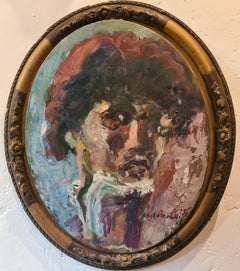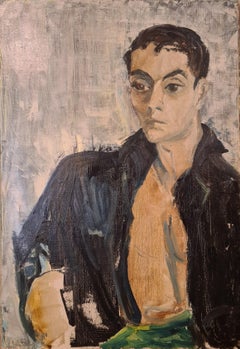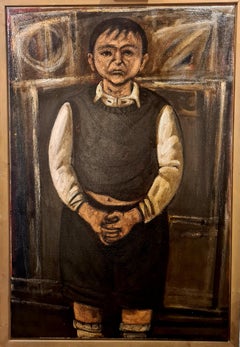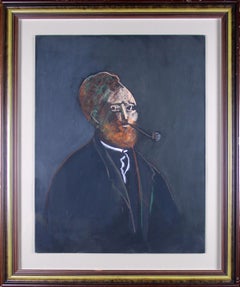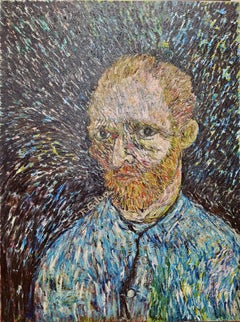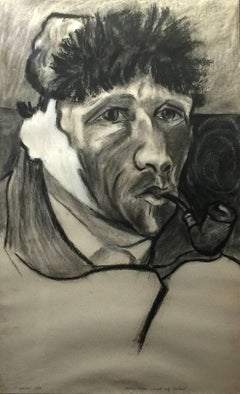Items Similar to Portrait of Vincent Van Gogh with Bandaged Ear and Pipe.
Video Loading
Want more images or videos?
Request additional images or videos from the seller
1 of 11
Portrait of Vincent Van Gogh with Bandaged Ear and Pipe.
$559.29
£421.81
€480
CA$773.27
A$866.19
CHF 454.96
MX$10,532.63
NOK 5,761.23
SEK 5,468.95
DKK 3,654.07
About the Item
Gouache and watercolour on corrugated cardboard after the famous self portrait by Vincent van Gogh with his fur hat, bandaged ear and pipe. This painting is by Jean Ducel who has played with the original image and background to give it an element of humour.
Painted in 1889 Vincent van Gogh's self-portrait with bandaged ear and pipe is a striking depiction of a troubled master. The painting shows the artist in three-quarter profile standing in a room in the Yellow House wearing a closed coat and a fur cap. His right ear is bandaged, although it was actually his left ear that was bandaged, the painting being a mirror image. To his right is an easel with a canvas on it.
In February 1888, Vincent moved to Arles to begin his dream of starting an artist colony, painting in the south of France in a more direct light. He loved the landscape, the light, and the people. The first step was finding a house and setting up a studio. He found that in a small yellow house on No. 2 Place Lamartine for 15 francs per month.
Part two of the plan was getting another painter to stay with him and paint. The previous year, in 1887, Paul Gauguin moved to Paris where he met Vincent. Vincent's brother Theo, an art dealer was representing Gauguin and introduced the two. Vincent respected Gauguin and thought him the perfect painter to join him in Arles. With some convincing from Theo, Gauguin agreed and arrived on October 23rd, meeting Vincent at the door of the yellow house early in the morning.
The painters got along well for weeks. They ate together, they drank together, and they painted together. In the small house they were together almost all of the time. Van Gogh and Gauguin both had an interest in Impressionism and painted the same subjects. They painted side by side, showing how two painters can show the same scene in different ways.
Things didn't stay happy for long. Eventually, Gauguin was finding it hard to live with Vincent. Gauguin felt that they had accomplished a lot, and that his views on art were becoming increasingly different than those of Vincent. This situation was becoming stressful for both men. At times Vincent still showed affection to Gauguin, but at others he detested him.
By December, Gauguin was thinking about leaving. He wrote to another painter "I'm staying for now, but I'm poised to leave at any moment." Finally, on December 23rd, Vincent asked Gauguin if he was planning to leave. When Gauguin said yes, Vincent was devastated. He tore out a sentence from a newspaper, stating simply "The Murderer took flight" and handed it to Gauguin. After supper Gauguin left the house to go for a walk. Barely out of the yellow house, he heard the footsteps of Vincent approaching. When he turned to look, he saw Vincent walking towards him with a razor in his hand. Vincent stopped, put his head down, and quickly returned home.
The details of the rest of the evening are sparse, as van Gogh often awoke after his times of "madness" with little recollection of the previous events. From what we can gather from accounts from Gauguin, the police, and his brother Theo, Vincent returned home while Gauguin stayed in a hotel. Later that night, after 10:00 P.M., Vincent took a razor and cut off a portion of his left ear. The police would find blood all over the house, with blood soaked rags in the studio and bloody handprints along the wall leading upstairs. Vincent took the ear and wrapped it in newspaper. With a hat pulled down over his wound, he, with ear in hand, left the house to go to a "maison de tolerance", a brothel close to the house. There he asked for a girl named Rachel who he gave the ear to saying "Guard this object carefully."
The next night when Gauguin woke up and started to return to the yellow house he saw the police in front with a crowd of onlookers surrounding. When the police found Vincent in his bed, covered in blood, they initially thought he was dead, perhaps by suicide. Gauguin felt the body and discovered that Van Gogh was still alive. He asked the police to wake him gently, and if Vincent asks for Gauguin, to say that he had returned to Paris. Vincent was taken to a hospital to recover, where he continuously requested to see or talk to his friend Gauguin. He still thought his friendship could be salvaged, and he was already planning new paintings.
It seems an odd and harsh reaction for Vincent to cut off his ear. But Vincent van Gogh was deeply troubled and his mind made connections that appear mad. More than anything Vincent wanted the situation to work. He wanted a place where artists lived together, painted, talked about painting, and learned from each other. Van Gogh felt his idea was happening with the arrival of Gauguin. And then, he knew that he ruined it. He blamed himself for not being able to get along with Gauguin. Just as with past relationships, this too fell apart.
- Dimensions:Height: 16.15 in (41 cm)Width: 12.8 in (32.5 cm)
- Medium:
- After:(After) Vincent van Gogh (Dutch)
- Period:
- Condition:Good condition bearing in mind the medium of corrugated cardboard.
- Gallery Location:Cotignac, FR
- Reference Number:Seller: LG/Ducel/VanGogh.1stDibs: LU1430215007972
About the Seller
5.0
Platinum Seller
Premium sellers with a 4.7+ rating and 24-hour response times
Established in 2000
1stDibs seller since 2020
249 sales on 1stDibs
Typical response time: <1 hour
- ShippingRetrieving quote...Shipping from: Cotignac, France
- Return Policy
Authenticity Guarantee
In the unlikely event there’s an issue with an item’s authenticity, contact us within 1 year for a full refund. DetailsMoney-Back Guarantee
If your item is not as described, is damaged in transit, or does not arrive, contact us within 7 days for a full refund. Details24-Hour Cancellation
You have a 24-hour grace period in which to reconsider your purchase, with no questions asked.Vetted Professional Sellers
Our world-class sellers must adhere to strict standards for service and quality, maintaining the integrity of our listings.Price-Match Guarantee
If you find that a seller listed the same item for a lower price elsewhere, we’ll match it.Trusted Global Delivery
Our best-in-class carrier network provides specialized shipping options worldwide, including custom delivery.More From This Seller
View AllFrench Impressionist Oil on Canvas after Cézanne, Le Jardinier, The Gardener
By After Paul Cezanne
Located in Cotignac, FR
French Impressionist Oil on Canvas after a painting by Paul Cézanne titled 'Le Jardinier Vallier' (R950, FWN547). The painting is titled and signed 'élève de beaux arts d' Aix' to th...
Category
Mid-20th Century Impressionist Figurative Paintings
Materials
Canvas, Oil
$1,025 Sale Price
20% Off
French Expressionist Self Portrait. Oil on Canvas.
Located in Cotignac, FR
Expressionist oil on canvas self portrait of the artist Stéphane LOVIGHI-BOURGOGNE. The painting is signed bottom right and is signed and dated to the back of the canvas. Presented i...
Category
Late 20th Century Portrait Paintings
Materials
Oil, Canvas
$2,190 Sale Price
41% Off
'Insouciance', Mid 20th Century Portrait of Max Vigon friend of Jean Cocteau.
By Jean Cocteau
Located in Cotignac, FR
French Mid 20th Century oil portrait of the actor Max Vigon. The sitter was a friend and collector of the works of Jean Cocteau. By repute this portrait is by Cocteau however it is n...
Category
Mid-20th Century Portrait Paintings
Materials
Canvas, Oil
'Him', A Large Glasgow School Oil Painting Portrait on Canvas.
Located in Cotignac, FR
A large Glasgow School oil on canvas portrait by Scottish artist Stuart Mackenzie. The painting is presented in a plain baton wood frame.
Though not ...
Category
Late 20th Century Young British Artists (YBA) Figurative Paintings
Materials
Canvas, Oil
$2,610 Sale Price
20% Off
Large French Expressionist Oil Portrait, The Seated Beauty.
Located in Cotignac, FR
Large French Mid 20th Century, oil on paper laid on canvas, portrait of a seated female figure by Sylvain Vigny. The painting is signed bottom left and presented in a very fine carve...
Category
Mid-20th Century French School Portrait Paintings
Materials
Canvas, Paper, Oil
'The Papakha', A Pre Revolutionary Nobleman From the Caucasus. Oil on Canvas.
Located in Cotignac, FR
A large French oil on canvas portrait of a dignitary from the Caucasus by Théophile Paul Marie Bérengier. The painting is signed and dated b...
Category
1890s Portrait Paintings
Materials
Oil, Canvas
You May Also Like
Portrait of Van Gogh
By Jack Hooper
Located in San Francisco, CA
Jack Hooper
Portrait of Van Gogh, ca. 2005
Oil on cardboard
Unframed dimensions: 35 x 28 inches
Framed dimensions: 40 x 33 in
This one-of-a-kind contemporary portrait of Vincent Van...
Category
21st Century and Contemporary Contemporary Portrait Paintings
Materials
Oil Crayon, Oil, Cardboard
Self-portrait after Van Gogh, by Henrico (Richio) Galvez
Located in San Francisco, CA
Given Vincent Van Gogh’s mental state when he painted his September 1889 self-portrait, possibly his last, it would be risky business by another artist to produce his own self-portra...
Category
21st Century and Contemporary Post-Impressionist Portrait Paintings
Materials
Canvas, Oil
Original Vintage Art Exhibition Poster Vincent Van Gogh Self Portrait Painting
By Vincent van Gogh
Located in London, GB
Original vintage art exhibition poster - Vincent van Gogh gemalde aquarelle zeichnungen / paintings watercolours drawings - organised by the Volkswagen werk AG Stadthalle Worfsburg a...
Category
Vintage 1960s German Posters
Materials
Paper
Sketch After Vincent Self Portrait No. 3
By Wes Olmsted
Located in Buffalo, NY
An original watercolor painting by Westley "Wes" Olmsted. This work is currently featured in the exhibition Man of Extremes at Benjaman Gallery in Buffalo, NY.
Westley G. Olmsted (1934-2011) was a painter and sculptor. He was born in Buffalo, New York, and was a distant relative Frederick Law Olmsted...
Category
1970s Modern Portrait Drawings and Watercolors
Materials
Charcoal, Paper
Bearded man with pipe and hat
Located in Genève, GE
Work on wood
Carved wooden frame
41 x 36.5 x 7 cm
Category
Early 20th Century Dutch School Portrait Paintings
Materials
Oil
After Vincent Van Gogh’s “Dr. Gachet” by Henrico (Richio) Galvez
Located in San Francisco, CA
The inspiration for this work was Vincent Van Gogh’s “Portrait of Dr. Gachet.” Both versions of the original perceptively convey the sitter’s sense of utter frustration, perhaps at h...
Category
21st Century and Contemporary Post-Impressionist Paintings
Materials
Canvas, Oil
More Ways To Browse
Vincent De Paul
Vintage Police Art
Dead Body
Vintage Stop Light
Vincent Van Gogh Original
House Alive Vintage
Easel Mirror
Long Evening Coat
Brothel Paintings
Hard Hat Vintage
Vintage Fur Wrap
Retro Long Fur Coat
Mens Used Fur Coats
Evening Coat Fur
Hospital Bed
Suicide Girls
Happy Cappers Hat
Diana Painting 17th Century
